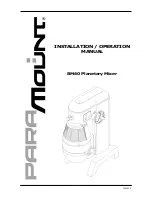
27
APPENDIX A: Service Info
•
Is the channel’s
VOLUME
control and
the
MAIN MASTER
control properly set?
Refer to the “Level Setting Procedure” on
page 6.
•
Is there something plugged into the
channel’s
INSERT
jack? Plugging into the
INSERT
jack breaks the signal path for
the channel. Try unplugging any
INSERT
devices. If that fixes the problem, make
sure you’re using a properly wired send/
return cable (see “Making the Connec-
tions” on page 21). Make sure the
volume (gain) controls on the external
processor connected to the
INSERT
jack
are properly set.
•
Is there something plugged into the
POWER AMP IN
jacks? Plugging into the
POWER AMP IN
jacks breaks the signal
path between the mixer and the ampli-
fier. However, the signal source you have
plugged into the
POWER AMP IN
jacks
should be heard over the speakers
connected to the
SPEAKER OUT
jacks.
•
Do you have any external equalizers,
compressors or processors connected
between the
MIXER OUT
and
POWER
AMP IN
jacks? If so, make sure they are
working correctly.
•
Are there fuses in the speaker or in-line
fuses in the speaker wire? Check ’em to
see if they’re blown.
•
Are the speakers working properly? If
you have another amplifier that you
know works, plug the speakers into it to
make sure they work.
One side is way louder than the other!
For the 408S and 808S:
•
Do the
LEVEL
meters read the same on
both sides? If not, the
PAN
control on
the signal source’s channel strip may be
turned too far to one side. If you’re using
a stereo signal source, it may be deliver-
ing an out-of-balance stereo signal.
•
Try swapping sides: Turn off the powered
mixer, swap the speaker cables at the
SPEAKER OUT
jacks, turn the mixer
back on. If the same side is still louder,
the problem is with your speakers or
speaker cabling. If the other side is
louder now, the problem is with the
mixer, the amp, or the signal source.
Warranty Service
If you think your powered mixer has a prob-
lem, please do everything you can to confirm it
before calling for service, including reading
through the following Troubleshooting section.
Of all Mackie products returned for service
(which is hardly any at all), many are coded
“CND” — Could Not Duplicate, which usually
means the problem lay somewhere else in the
system. Here are some things you can check:
Troubleshooting
No power!
•
Our favorite question: Is it plugged in?
Make sure the AC outlet is live (check
with a tester or lamp).
•
Our next favorite question: Is the
POWER
switch on? If not, try turning it on.
•
Is the green
POWER
light on the front
panel illuminated? If not, make sure the
AC outlet is live. If so, refer to “No
sound” below.
•
The AC line fuse inside the mixer is
blown. This is not a user-serviceable
part. Refer to “Repair” on page 28 to find
out how to proceed.
No sound!
•
Are the
INPUT LEVEL SET
controls
turned all the way down? Follow the
procedures in the “Quick Start” section
on page 6 to verify that all the level and
volume controls are properly adjusted.
•
Is the signal source working (and
making union scale)? If it’s a micro-
phone, make sure the mic cable is in
good repair and securely connected at
both ends. If it’s a condenser micro-
phone, make sure the
PHANTOM
POWER
switch is turned on. If it’s an
instrument, again make sure the con-
necting cables are in good repair and
securely connected at both ends. Make
sure the output volume (gain) control
for the instrument is turned up suffi-
ciently to drive the inputs of the mixer.
You should be able to see the
INPUT
LEVEL SET
LED blink when you turn up
the
INPUT LEVEL SET
control.
If you’re monitoring the
TAPE IN
, make
sure the tape deck’s Tape/Source switch
is set to “Tape,” and make sure the
TAPE
IN LEVEL
control on the powered mixer
is turned up to unity (center position).
Содержание 406M
Страница 35: ...35 NOTES...










































